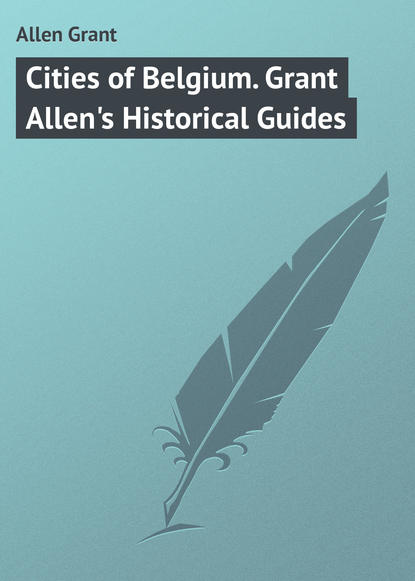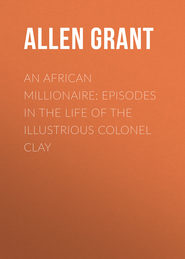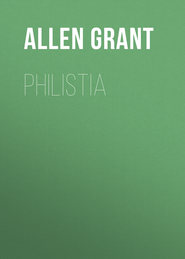По всем вопросам обращайтесь на: info@litportal.ru
(©) 2003-2024.
✖
Cities of Belgium. Grant Allen's Historical Guides
Настройки чтения
Размер шрифта
Высота строк
Поля
On leaving the Cathedral, go round the south side, which affords an excellent view of the chapels built out from the apse. Then take the little Rue du St. Esprit as far as the Church of
Notre-Dame,
which replaces a chapel, built by St. Boniface, the Apostle of Germany, in 744, and enclosed in the town in 909.
Stand opposite it, in the small Place on the N. side, to observe the somewhat shapeless architecture, the handsome brick tower crowned by a tall brick steeple, and the beautiful little *porch or “Paradise,” built out from the main structure in flamboyant Gothic of the 15th century. The portal of this porch has been walled up, and the area is now used as a chapel, approached from the interior. Notice the delicate tracery of the windows, the fine finials and niches, and the charming gable-end.
The picturesque building with turrets to the L. of the church was originally the mansion of the family Van der Gruuthuus, one of the principal mediæval stocks of Bruges. It had a passage communicating with the family gallery in the church of Notre-Dame. The building, recently restored, is now in course of being fitted up for the Town Museum of Antiquities. A Museum of Lace is already installed in it; the entrance is by a doorway over the bridge to the left (50 c. per person).
Enter the church, and walk straight into the Nave, below the great West Window, a spot which affords a good view of the centre of the church, the vaulted double Aisles, and the angular Apse. The Choir is shut off from the body of the church by a very ugly marble Rood-Screen (1722), still bearing its crucifix, and with a figure of Our Lady, patroness of the church, enshrined above its central arch. Rococo statues of the Twelve Apostles, with their well-known symbols (1618), are attached to the pillars. (Note these symbols: they recur in similar situations everywhere.) In spite of hideous disfigurements, the main portion of the interior is still a fine specimen of good middle Gothic architecture, mainly of the 14th century.
Walk up the outer left Aisle. The last bay is formed by the Baptistery, originally the porch, whose beautiful exterior we have already viewed. Its interior architecture is also very charming. It contains the Font, and the usual figure of the patron, St. John the Baptist. This Aisle terminates in an apsidal chapel (of the Holy Cross) containing inferior pictures of the 17th century, representing the history of a relic of the True Cross preserved here.
The inner left Aisle leads to the Ambulatory or passage at the back of the Choir. The Confessionals to the R. have fairly good rococo carved woodwork, 1689. On the L. is the handsome mediæval woodwork gallery (1474), belonging to the Van der Gruuthuus family, originally approached by a passage from their mansion behind. Beneath it, is a screen of delicate early Gothic architecture, with family escutcheons above the door.
The windows of the Apse have good modern stained glass.
On the L., at the entrance to the Apse, Pourbus’s Adoration of the Shepherds, a winged picture, closed. The sacristan will open it. On the wings are, left, the donor, Sire Josse de Damhoudere, with his patron, St. Josse, and his four sons; right, his wife, Louise, with her five daughters, and her patron St. Louis of France, wearing his crown and robe of fleurs-de-lis, and holding the main de justice. He is represented older than is usual, or indeed historical, and in features somewhat resembles Henri IV. This is a fine picture for its master. On the outer wings are the cognate subjects, the Circumcision and the Adoration of the Magi, in grisaille.
The chapel in the Apse, formerly the Lady Chapel, now contains the Host. It has a gaudy modern altar for the monstrance.
In the South Ambulatory, over a doorway, Foundation of the Church of Santa Maria Maggiore at Rome, by Claeissens.
A chapel to the L., just beyond, locked, but opened by the sacristan (1 franc; or, for a party, according to notice displayed at entrance), contains the celebrated **tombs of Mary of Burgundy and Charles the Bold, her father. Mary was the wife of Maximilian, and died by a fall from her horse in 1482, when only twenty-five. Her **monument was designed and executed by Peter Beckere of Brussels, by order of her son Philippe le Beau, in 1502. The sarcophagus is of black marble: the statue of the Princess, in gilt bronze, lies recumbent upon it. The style is intermediate between that of the later Middle Ages and of the full Renaissance. Beside it is the *tomb of Charles the Bold, of far less artistic value. Charles was buried at Nancy, after the fatal battle, but his body was transported to St. Donatian in this town by his descendant Charles V, and finally laid here beside his daughter by Philip II, who had this tomb constructed for his ancestor in imitation of that of Mary.
(I advise the visitor after seeing these tombs and the great chimney-piece of the Franc de Bruges to read up the history of Charles the Bold and his descendants, down to Charles V.)
The east wall of this chapel, beyond the tomb of Charles the Bold, has a fine picture of Our Lady of Sorrows, enthroned, surrounded by smaller subjects of the Seven Sorrows. Beginning at the left, the Circumcision, the Flight into Egypt, Christ lost by his parents in the Temple, the Way to Calvary, (with St. Veronica holding out her napkin,) the Crucifixion, (with Our Lady, St. John, and Mary Magdalen,) the Descent from the Cross, and the Deposition in the Tomb. A fine work of its sort, attributed to Mostart (or to Maubeuge). On the west wall are two wings from a triptych by Pourbus, with tolerable portraits, (centre-piece destroyed,) and an early Flemish painting of the Deposition from the Cross (interesting for comparison with Roger van der Weyden and Gerard David). In the foreground lies the vessel containing the Holy Blood. On the wings are the Crucifixion and the Resurrection. The whole is very rudely painted. Outside are portraits of the donor and his wife and children, with their patrons St. James (staff and scallop) and St. Margaret (whose dragon just appears in the background).
On an arcade, a little further on, is a very early fresco (1350?) of a saint (St. Louis of France?), and also a dainty small relief (about 1500) of a donor, introduced by his patron, St. Peter, adoring Our Lady.
The end chapel of the right aisle, that of the Holy Sacrament, contains a celebrated and noble white marble **Madonna and Child, by Michael Angelo, enshrined in a black marble niche. The pensive, grave, and graceful face, the exquisite modelling of the dainty naked Child, and the beautiful infantile pose of its left hand, all betray a design of Michael Angelo, though the execution may possibly have been left to pupils. But the modelling is softer and more feminine than is usual with this great sculptor, except in his early period. In this respect, it resembles most the unfinished Madonna in the Bargello at Florence. Condivi mentions that Peter Mouscron of Bruges ordered of Michael Angelo a Madonna and Child in bronze: he was probably mistaken as to the material: and we have here doubtless the work in question. Apart from its great artistic value, this exquisite group is interesting as affording another link between Flanders and Italy.
The same chapel also contains some good 17th century pictures.
Near the confessional, as we return towards the West End of the church, we find a good diptych of Herri met de Bles, of 1520, containing, left panel, an Annunciation, with all the conventional elements; to the left, as usual, is the angel Gabriel; to the right, Our Lady. These relative positions are never altered. The lilies in the pot, the desk and book, the bed with its furniture, the arcade in the background, and the rich brocade, are all constant features in pictures of this subject. Look out for them elsewhere. The right panel has the Adoration of the Magi, with the Old, Middle-aged, and Young Kings, the last-named a Moor. This quaint and interesting work of a Flemish painter, with its archaic background, and its early Italian reminiscences, also betrays the influence of Dürer. Among the other pictures may be mentioned a triptych in an adjacent small chapel: the central panel shows the Transfiguration, with the three apostles below, Moses, Elias, and the Eternal Father above (perhaps by Jan Mostart). On the wings (much later, by P. Pourbus), are the portraits of the donor, his wife, and their patron saints.
The West Wall of the church has several large pictures of the later Renaissance, which can be sufficiently inspected on their merits by those who care for them. The best of them are the Adoration of the Magi by Seghers, and De Crayer’s Adoration of the Infant Jesus. I do not propose to deal at length with later Flemish art till we reach Brussels and Antwerp: at Bruges, it is best to confine oneself to the introductory period of Flemish painting – that of the Burgundian princes. I will therefore only call attention here to the meaningless way in which huge pictures like B. van Orley’s Crucifixion, with subsidiary scenes from the Passion, reproduce the form of earlier winged pictures, which becomes absurd on this gigantic scale.
The Church of St. Jacques stands in the street of the same name, conveniently near the Hôtel du Commerce. It is a good old mediæval building (12th century, rebuilt 1457-1518), but hopelessly ruined by alterations in the 17th century, and now, as a fabric, externally and internally uninteresting. Its architecture is in the churchwarden style: its decoration in the upholsterer’s. The carved wooden pulpit is a miracle of bad taste (17th century), surpassed only by the parti-coloured marble rood-screen. A few good pictures and decorative objects, however, occur among the mass of paintings ranged round its walls as in a gallery. The best is a panel of the old Flemish School (by Dierick Bouts, or more probably a pupil), in the left aisle, just beyond the second doorway. It tells very naïvely the History of St. Lucy (see Mrs. Jameson). Left, she informs her mother that she is about to distribute her goods to the poor, who are visibly represented in a compact body asking alms behind her. Centre, she is hailed before the consul Paschasius by her betrothed, whom she refuses to marry. She confesses herself a Christian, and is condemned to a life of shame. Right, she is dragged away to a house of ill-fame, the consul Paschasius accompanying; but two very stumpy oxen fail to move her. The Holy Ghost flits above her head. The details are good, but the figures very wooden. Dated, 1480.
Beside it is an extravagant Lancelot Blondeel of St. Cosmo and St. Damian, the doctor saints, with surgical instruments and pots of ointment. The central picture shows their martyrdom.
Further on hangs a good Flemish triptych (according to Waagen, by Jan Mostart), representing, the prophecies of Christ’s coming: centre, the Madonna and Child; with King Solomon below, from whom a genealogical tree rises to bear St. Joachim and St. Anna, parents of Our Lady. R. and L. of him, Balaam and Isaiah, who prophesied of the Virgin and Christ: with two Sibyls, universally believed in the Middle Ages to have also foretold the advent of the Saviour. The stem ends in the Virgin and Child. Left, the Tiburtine Sibyl showing the Emperor Augustus the vision of the glorious Virgin in the sky: right, St. John the Evangelist in Patmos beholding the Apocalyptic vision of the Woman clothed with the Sun. This is a fine work of its kind, and full of the prophetic ideas of the Middle Ages.
Pass round the Ambulatory and Choir to the first chapel at the east end of the right Aisle. It contains an altar with the Madonna and Child in Della Robbia ware, probably by Luca. Also, a fine tomb of Ferry de Gros and his two wives, the first of whom reposes by his side and the second beneath him. This is a good piece of early Renaissance workmanship (about 1530). The church also contains a few excellent later works by Pourbus and others, which need not be specified. This was the church of the Florentine merchants at Bruges (whence perhaps the Della Robbia) and particularly of the Portinari, who commissioned the great altar-piece by Van der Goes now in the Hospital of Santa Maria Nuova at Florence.
The other churches of Bruges need not detain the tourist, though all contain a few objects of interest for the visitor who has a week or two at his disposition.
F. THE ACADEMY
[The Académie des Beaux-Arts, which formerly occupied the Poorters Loodge (or Guild Hall of the citizens within the gates) has a small but valuable collection of pictures, removed from the destroyed cathedral of St. Donatian and other churches of Bruges, which well repays a visit. You will here have an excellent opportunity for studying Jan van Eyck, whose work I shall more particularly notice when we arrive at Ghent. It is interesting, however, here to compare him with his great successor, Memling, who is represented at the Academy by a fine triptych. The little gallery also contains some admirable works by Gerard David, one of the latest of the old School of Flemish painters, whose work may thus be observed here side by side with those of his two chief predecessors. Owing to the ruinous state of the original building the collection has been transferred to a temporary apartment, beyond the Hospital bridge, near the Church of Notre-Dame. No tourist should leave Bruges without visiting this interesting collection.]
The Museum is situated (at present) in a house on the right-hand side of the Rue Ste. Catherine, nearly opposite a new church. Go to it past the Hospital of St. John. Admission daily, 50 c. per person.
Begin in the centre of the wall opposite the entrance.
(1.) Jan van Eyck. **Altar-piece, ordered by George van der Palen, for the High Altar of the original Cathedral of St. Donatian, of which he was a canon. The centre of the picture is occupied by the Madonna and Child, the face of Our Lady somewhat recalling German models. She sits in the apse of a church, probably St. Donatian. The Child, whom it is the fashion to describe as “aged-looking,” fondles a parrot and grasps a bunch of flowers. To the left stands St. Donatian the Archbishop, patron saint of the church for which this altar-piece was painted. He bears his usual symbol, the wheel with five lighted candles (as in the beautiful panel by Gerard David in the National Gallery at London). This is a fine and finely-painted figure. To the right, St. George, in full armour, admirably represented, but in an affected attitude, lifts his casque somewhat jauntily as he presents his namesake the Canon George to Our Lady. In all this we get a touch of Burgundian courtliness: the event is represented as a state ceremonial. With his left hand the Saint supports his Red Cross banner. The portrait of the kneeling Canon himself, – asthmatic, pudding-faced – is very admirable and life-like, but by no means flattered. He grips his prayer-book with an old man’s tremulous hand. (For a profound criticism of this fine picture, see Conway.) The insipid Madonna, the rather foolish St. George, the fine portrait of the Canon, are all typical of Van Eyck’s manner. The accessories of architecture, decoration, and background, should also be carefully noted. The capitals of the columns and the knobs of glass in the window, as well as St. George’s costume, are elaborated in Van Eyck’s finest fashion.
(2.) Jan van Eyck. *Portrait of his wife, painted for presentation to the Bruges Guild of Painters, together with one of the artist himself, now undiscoverable. This is a fine though evidently unflattered portrait of a capable housewife, very stiffly arrayed in her best church-going costume. It deserves close inspection.
Above it, (3.) Head of Christ, ascribed to Jan van Eyck, but in reality a poor and reduced copy of the picture at Berlin.
(4.) Memling. **Triptych painted for Willem Moreel or Morelli, a member of a wealthy Savoyard family settled at Bruges. Like Jan van Eyck’s portrait of the two Arnolfini in London, and Hugo van der Goes’s triptych of the Portinari at Florence, this picture marks well the cosmopolitan character of old Bruges. In the central panel, St. Christopher (whose altar in the church of St. Jacques it adorned) wades with his staff through the water, feeling as he goes the increasing burden of the Christ-Child on his shoulder. (For the legend, see Mrs. Jameson.) To the left, above, is the diminutive figure of the hermit with his lantern, which always accompanies St. Christopher. The left foreground of the picture is occupied by St. Maurus, in his Benedictine costume; to the right is St. Giles (St. Egidius) the hermit, with the wounded doe, the arrow piercing the arm of the saint. The left wing represents the donor, Willem Moreel, under the care of his patron, St. William, who wears a hermit’s dress above his coat of armour. (When a saint places his hand on a votary’s shoulder it usually implies that the votary is a namesake.) Behind are Moreel’s five sons. All these portraits, but particularly that of the donor and his eldest son, who closely resembles him, are admirable. The right wing represents the donor’s wife, Barbara, under the protection of her patron, St. Barbara, with her tower, showing as usual three windows (emblematic of the Holy Trinity). Behind the lady are her two daughters, one of whom is habited as a Benedictine nun, whence, doubtless, the introduction of St. Maurus into the main altar-piece. This fine triptych originally decorated an altar of St. Christopher in Moreel’s private chapel in the church of St. Jacques. One of his daughters is the “Sibylla Sambetha” represented at the Hospital. The wings at the back represent in grisaille St. John the Baptist with the lamb, and St. George with the dragon. It was usual to paint the outer wings in grisaille or in low tones of colour, so that the splendour of the interior hues might burst upon the spectator as the triptych was opened.
(12) Attributed to Schoreel: really, by a master of the Brabant School. Death of the Virgin. Our Lady is represented on her deathbed, surrounded, as always, by the surviving apostles, who were miraculously collected together to her chamber. The faces are those of Flemish peasants or artisans. Above, Christ appears in glory, surrounded by a halo of cherubs, to receive her new-born soul. Two angels support his outer garment. This picture well shows the beginning of the later Flemish tendency.
Now return to No. 5, by Gerard David, on the other side of the great Van Eyck. This is a *triptych, painted for Jean des Trompes, for the High Altar of the lower chapel of the Holy Blood. The central panel represents the Baptism of Christ. In the middle, the Saviour wades in the water of a diminutive Jordan, where the concentric circles show the increased careful study of nature. On the right-hand side of the picture, St. John-Baptist, patron saint of the donor, pours water on his head. The relative positions of these two figures, and of the angel to the left holding a robe, are conventional: they have descended from a very early period of art. (In the Ravenna mosaics, the place of the angel is filled by the river-god of the Jordan with his urn, afterwards transformed and Christianized into an angel with a towel. Look out in future for similar arrangements.) The central figures are weak; but the robe of the angel is painted with Flemish minuteness. So are the flowers and leaves of the foreground. Above, the dove descends upon the head of the Saviour, while the Eternal Father pronounces from the skies the words, “Behold my Beloved Son in whom I am well pleased.”
In the background are two other episodes: L., the preaching of St. John-Baptist (where Oriental costumes indicate the heathen); R., St. John-Baptist pointing out Christ to his disciples with the words, “Behold the Lamb of God.” The distance shows two towns and a fine landscape. Observe the admirable painting of the trees, with their good shadows; also the ivy climbing up the trunk of one to the right. This picture is among the earliest in which the gloom of a wood is accurately represented: in many other respects it well illustrates the rise of landscape-painting. (For an exhaustive criticism, see Conway.) The left wing has a portrait of the donor, with his other patron, St. John the Evangelist, holding the cup. Beside the donor kneels his little son Philip. This portrait, the face and foot of the Evangelist, the fur of the donor’s robe, the crane in the background, and many other accessories deserve close attention. Two figures in the background dimly foreshadow Teniers. The right wing has a portrait of the donor’s wife, Elizabeth, with her four daughters. Behind her stands her patroness, St. Elizabeth of Hungary, in Franciscan robes, with the crown on her head and the double crown and book in her hands, as on the statuette at the door of the Béguinage. The painting of a rosary here is excellent. The outer wings (turn them back) show, on the left, the Madonna and Child with a bunch of grapes; on the right, the donor’s second wife Madeleine, introduced by her patroness, St. Mary Madeleine, who holds the alabaster pot of ointment. By the lady’s side kneels her daughter. The background consists of a view, probably in the Bruges of that period. Painted about 1507.
6 and 7. Gerard David. *The Punishment of the Unjust Judge. These two panels are of a type commonly set up in courts of justice as a warning to evil-doers. They were ordered by the Bruges magistracy. You will see a similar pair by Dierick Bouts in Brussels. The story, a horrid one, is taken from Herodotus. Sisamnes was a judge in Persia whom King Cambyses detected receiving a bribe and ordered to be flayed alive. The king then stretched his skin on the seat of judgment, and appointed the son of Sisamnes to sit in his father’s place, that he might remember to avoid a like fate. The first picture represents, in the background, the bribery. In the foreground, King Cambyses, in a rich embroidered robe, demonstrates on his fingers the guilt of the unjust judge. Sisamnes is seized on his tribunal by a man of the people; courtiers, lawyers, and burgesses looking on. The expression on his face and the painting of all the accessories is admirable. In the second picture we have the flaying of the unjust judge, a horrible scene, powerfully rendered. Cambyses stands by, holding his sceptre, surrounded by courtiers who recall the last age of the Burgundian dominion. In the background (as a subsequent episode) the son of Sisamnes is seen sitting in his father’s place: behind him hangs the skin of the father. Architecture, landscape, ropes, and all other accessories of this painful picture should be carefully noted.
15. J. Prévost. Last Judgment. Below, the dead are rising, half naked, from the tomb, girt only with their shrouds; the good receiving garments from angels, and the bad hurried away to a very Flemish and unimpressive Hell. Above, Christ as Judge holds the sword. Two angels blow out the words of blessing or malediction. On the spectator’s left, Our Lady shows the breast that suckled the Redeemer. Behind her are St. Peter with the key, St. Paul with the sword, St. Bartholomew with the knife, and other saints. On the right are St. John-Baptist with the lamb, King David with the harp, Moses, horned (as always), with the tables of the law, and a confused group of saints. This picture is rather curious than beautiful. Above it is a later treatment of the same subject by Van Coornhuuse, interesting for comparison as showing the usual persistence of types and the conventional grouping of the individual figures. Compare especially the corresponding personages in the lower left-hand corners.
A few other pictures skied on this wall deserve passing notice. 29 is a Death and the Miser, of the School of Quentin Matsys. 17, by Lancelot Blondeel, the architect of the great chimney-piece of the Franc de Bruges, represents St. Luke painting Our Lady, in one of the fantastic frames in which this painter delighted. 18, by the same, has a St. George and the Dragon, with the Princess Cleodolind looking on. Around it are four smaller scenes of his martyrdom: (he was boiled, burnt with torches, dragged by a horse, and finally decapitated). 11, is a good diptych of the Flemish school, by an unknown contemporary of Gerard David. It represents, left, a donor, with his patron St. John the Almoner, holding his symbol, a sheaf of corn. On the right, his wife with her patroness, St. Godeliva. 28, is an Adoration of the Magi, where the Three Kings again illustrate the three ages of man and the three continents. Beside it is a Nativity which exhibits all the traditional features already noted.
The end wall has in its centre a tolerably good Adoration of the Magi, of the German School, 15th century. Note once more the Three Kings, of whom the youngest is a Moor. Left of this, a *drawing, by Jan van Eyck, of St. Barbara, which should be closely inspected. She holds a palm of martyrdom. In the background, workmen build her tower. It is interesting as a scene of real life at this period. This is a replica of the well-known picture at Antwerp. To the right, two coloured drawings by Gerard David from the life of St. John-Baptist. Above these hangs a tolerable P. Pourbus of the Last Judgment, valuable for comparison with the two previous treatments of the same subject on the principal wall. Go from one to the other once or twice. Later painters of the Renaissance use this solemn theme as a mere excuse for obtruding the nude – and often the vulgar nude – into churches. On the same wall are a good triptych in grisaille by P. Pourbus (Way to Calvary, Descent from the Cross, Resurrection: from Notre-Dame at Damme), and other pictures.
The remaining walls have portraits and other works, from the 17th century downwards, most of which need no explanation. A few of them, indeed, are not without merit. But, as I have before observed, it is best in mediæval Bruges to confine oneself to the 13th, 14th, 15th, and early 16th centuries, leaving the rise of the Renaissance, and the later Flemish School of painting, to occupy us at Antwerp, where they can be studied to far greater advantage.
II
GHENT
A. ORIGINS OF GHENT
FLANDERS owes everything to its water communications. At the junction of the Schelde with the Lys or Lei, there grew up in the very early Middle Ages a trading town, named Gent in Flemish, and Gand in French, but commonly Anglicised as Ghent. It lay on a close network of rivers and canals, formed partly by these two main streams, and partly by the minor channels of the Lieve and the Moere, which together intersect it into several islands. Such a tangle of inland waterways, giving access both to the sea and to Bruges, Courtrai, and Tournai, as well as less directly to Antwerp and Brussels, ensured the rising town in early times considerable importance. It formed the centre of a radiating commerce. Westward, its main relations were with London and the English wool ports; eastward with Cologne, Maastricht, the Rhine towns, and Italy. Ghent was always the capital of East Flanders, as Bruges or Ypres were of the Western province; and after the Counts lost possession of Arras and Artois, it became in the 13th century their principal residence and the metropolis of the country. The trade in weaving grew rapidly in importance, and the Ghenters received from their Count a charter of liberties of the usual mediæval burgher type. As time went on, and the city advanced in wealth, its subjection to its sovereigns became purely nominal. Ghent equipped large bodies of citizen soldiers, and repulsed a considerable English army under Edward I. The Ghenters were also determined opponents of the claims of the French kings to interfere in the internal affairs of Flanders; thus they were mainly instrumental in winning the famous Battle of the Spurs in 1302, when the citizens of Bruges and Ghent put to flight the army of France under the Count of Artois before the walls of Tournai, and dedicated as trophies 700 golden spurs, worn by the French knights whom they had routed. This battle, memorable as one of the chief triumphs of nascent industrial freedom over the chivalry and royalty of mediævalism, secured the liberties of the Flemish towns against French aggression.
Early in the 14th century, the burghers of Ghent, under their democratic chief, Jacob or Jacques Van Artevelde, attained practical independence. Till 1322, the Counts and people of Flanders had been united in their resistance to the claims of France; but with the accession of Count Louis of Nevers, the aspect of affairs changed. Louis was French by education, sympathies, and interests, and aristocratic by nature; he sought to curtail the liberties of the Flemish towns, and to make himself despotic. The wealthy and populous burgher republics resisted, and in 1337 Van Artevelde was appointed Captain of Ghent. Louis fled to France, and asked the aid of Philip of Valois. Thereupon, Van Artevelde made himself the ally of Edward III. of England, then beginning his war with France; but as the Flemings did not like entirely to cast off their allegiance – a thing repugnant to mediæval sentiment – Van Artevelde persuaded Edward to put forward his trumped-up claim to the crown of France, and thus induced the towns to transfer their fealty from Philip to his English rival. It was therefore in his character as King of France that Edward came to Flanders. The alliance thus formed between the great producer of raw wool, England, and the great manufacturer of woollen goods, Ghent, proved of immense commercial importance to both parties. But as Count Louis sided with Philip of Valois, the breach between the democracy of Ghent and its nominal sovereign now became impassable. Van Artevelde held supreme power in Ghent and Flanders for nine years – the golden age of Flemish commerce – and was treated on equal terms by Edward, who stopped at Ghent as his guest for considerable periods. But he was opposed by a portion of the citizens, and his suggestion that the Black Prince, son of Edward III., should be elected Count of Flanders, proved so unpopular with his enemies that he was assassinated by one of them, Gerard Denys. The town and states immediately repudiated the murder; and the alliance which Van Artevelde had brought about still continued. It had far-reaching results; the woollen industry was introduced by Edward into the Eastern Counties of England, and Ghent had risen meanwhile to be the chief manufacturing city of Europe.
The quarrel between the democratic weavers and their exiled Counts was still carried on by Philip van Artevelde, the son of Jacques, and godson of Queen Philippa of England, herself a Hainaulter. Under his rule, the town continued to increase in wealth and population. But the general tendency of later mediæval Europe towards centralised despotisms as against urban republics was too strong in the end for free Ghent. In 1381, Philip was appointed dictator by the democratic party, in the war against the Count, son of his father’s old opponent, whom he repelled with great slaughter in a battle near Bruges. He then made himself Regent of Flanders. But Count Louis obtained the aid of Charles VI. of France, and defeated and killed Philip Van Artevelde at the disastrous battle of Roosebeke in 1382. That was practically the end of local freedom in Flanders. Though the cities continued to revolt against their sovereigns from time to time, they were obliged to submit for the most part to their Count and to the Burgundian princes who inherited from him by marriage.
The subsequent history of Ghent is that of the capital of the Burgundian Dukes, and of the House of Austria. Here the German king, Maximilian, afterwards Emperor, married Mary of Burgundy, the heiress of the Netherlands; and here Charles V. was born in the palace of the Counts. It was his principal residence, and he was essentially a Fleming. Other historical reminiscences will be pointed out in the course of our peregrinations.
The old waterways, partially artificial, between Ghent and the sea, other than the circuitous route by the shallow Schelde, had silted up by 1827, when a ship canal was constructed to Terneuzen. This canal has since been widened and deepened so as to admit vessels of 1,700 tons; it has thus helped to some small degree to save the town from the fate of Bruges. But as its mouth lies in what is now Dutch territory, and as heavy tolls are levied, it is comparatively little used. Another and somewhat frequented canal leads to Bruges; but Ghent owes most of its existing prosperity to its manufactures (cotton, linen, engines, leather) and to its central position on the railway system.
The important points for the tourist to bear in mind are these, however. Ghent during the Middle Ages was a merchant republic, practically independent, with its guilds and its belfry, the last of which was used to summon the citizens to arms in case of danger. It was also the chief manufacturing town in Europe, as Bruges was the chief commercial centre. By treaty with Edward III., Bruges was made the “staple” or sole port of entry for English wool: and this wool was woven into cloth for the most part at Ghent.











